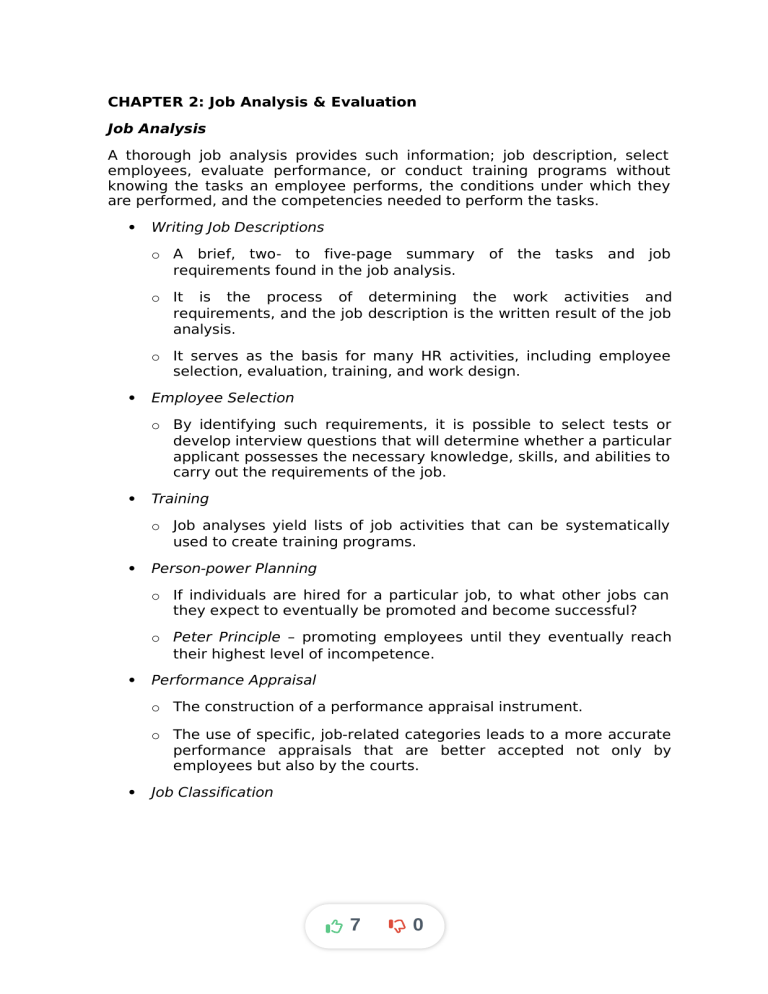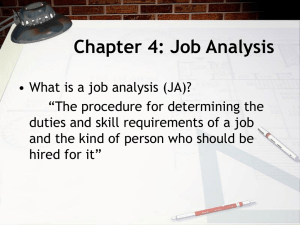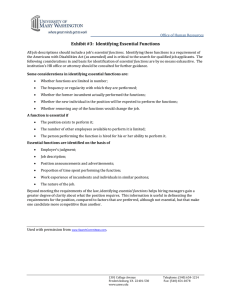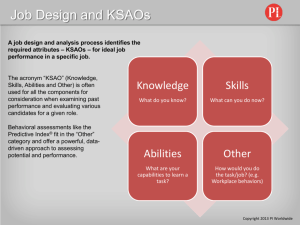
CHAPTER 2: Job Analysis & Evaluation Job Analysis A thorough job analysis provides such information; job description, select employees, evaluate performance, or conduct training programs without knowing the tasks an employee performs, the conditions under which they are performed, and the competencies needed to perform the tasks. Writing Job Descriptions o A brief, two- to five-page summary of the tasks and job requirements found in the job analysis. o It is the process of determining the work activities and requirements, and the job description is the written result of the job analysis. o It serves as the basis for many HR activities, including employee selection, evaluation, training, and work design. Employee Selection o By identifying such requirements, it is possible to select tests or develop interview questions that will determine whether a particular applicant possesses the necessary knowledge, skills, and abilities to carry out the requirements of the job. Training o Job analyses yield lists of job activities that can be systematically used to create training programs. Person-power Planning o If individuals are hired for a particular job, to what other jobs can they expect to eventually be promoted and become successful? o Peter Principle – promoting employees until they eventually reach their highest level of incompetence. Performance Appraisal o The construction of a performance appraisal instrument. o The use of specific, job-related categories leads to a more accurate performance appraisals that are better accepted not only by employees but also by the courts. Job Classification 7 0 o Enables a human resources professional to classify jobs into groups based on similarities in requirements and duties. o It is useful for determining pay levels, transfer, and promotions. Job Evaluation o Job analysis information can also be used to determine the worth of the job. Job Design o By analyzing a job, wasted and unsafe motions can be eliminated, resulting in higher productivity and reduced numbers of job injuries. Compliance with Legal Guidelines o No law specifically requires a job analysis, but several important guidelines and court cases mandate job analysis for all practical purposes. 1. The Uniform Guidelines on Employee Selection Procedures (1978) – the HR principles designed to ensure compliance with federal standards-contain several direct references to the necessity of job analysis. 2. The concept of job relatedness. Organizational Analysis o The discovery of such lapses in organizational communication can be used to correct problems and help an organization function better. Writing a Good Job Description A job description is a relatively short summary of a job and should be about two to five pages in length. 1. Those duties can always be added to a job description, which can, and should, be updated on a regular basis. 2. The phrase “and performs other job-related duties as assigned” should be included in the job description. 7 0 Job Title o An accurate title describes the nature of the job. o An accurate title also aids in employee selection and recruitment. o Job titles provide workers with some form of identity. o Job titles can also affect perceptions of the status and worth of a job. Brief Summary o The summary need be only a paragraph in length but should briefly describe the nature and purpose of the job. o It can be used in help-wanted advertisements, internal jobs, and company brochures. Work Activities o This section lists the tasks and activities in which the worker is involved. o These tasks and activities should be organized into meaningful categories to make the job description easy to read and understand. Tools & Equipment Used o A section should be included that lists all the tools and equipment used to perform the work activities in the previous section. o Information in this section is used primarily for employee selection and training. Job Context o This section should describe the environment in which the employee works and should mention stress level, work schedule, physical demands, level of responsibility, temperature, number of coworkers, degree of danger, and any other relevant information. o It is also important in providing applicants with disabilities with information they can use to determine their ability to perform a job under a particular set of circumstances. Work Performance 7 0 o This section contains a relatively brief description of how an employee’s performance is evaluated and what work standards are expected of the employee. Compensation Information o This section of the job description should contain information on the salary grade, whether the position is exempt, and the compensable factors used to determine salary. Job Competencies o This section contains what are commonly called job specifications or competencies. o These are the knowledge, skills, abilities, and other characteristics (KSAOs) (such as interest, personality, and training) that are necessary to be successful on the job. o Two Sub-sections of Job Competencies: 1. Contains KSAOs that an employee must have at the time of hiring. (Used for employee selection.) 2. Contains the KSAOs that are an important part of the job but can be obtained after being hired. (Used for training purposes.) Preparing for a Job Analysis Who will conduct the analysis? o A job analysis is conducted by a trained individual in the human resources department, but it can also be conducted by job incumbents, supervisors, or outside consultants. o The Uniform Guidelines state that a job analysis must be “professionally conducted,” and a job analyst certainly cannot be called a professional unless she has been trained. How often should a job description be updated? o The typical answer is that a job description should be updated if a job changes significantly. o Job Crafting – the informal changes that employees make in their jobs. 7 0 o It is common for employees to quietly expand the scope of their joints to add tasks they want to perform and to remove tasks that they don’t want to perform. Which employees should participate? o For organizations with relatively few people in each job, it is advisable to have all employees participate in the job analysis, o In organizations in which many people perform the same job, every person needs not to participate. o “How many people need to be included in the job analysis?” The answer to this question to some extent depends on whether the job analysis will be committee based or field based: In a committee-based job analysis, a group of subject matter experts meet to generate the tasks performed, the conditions under which they are performed, and the KASOs needed to perform them. In a field-based job analysis, the job analyst individually interviews/observes a number of incumbents out in the field. o Job Competence Sanchez, Prager, Wilson, & Viswesvaran (1998) and Mullins & Kimbrough (1998) that high-performing employee generated different job analysis outcomes than did low-performing employees. Ansoorian & Shultz (1997) found moderate differences in physical effort made by employees with varying levels of expertise. Landy & Vasey; (1991) and Prien, Prien & Wooten (2003) found that more experienced employees rated tasks differently than less experienced employees. Mailhot (1996) did not find any differences in job analysis ratings made by employees of different performance levels. o Race 7 0 Aamodt, Kimbrough, Keller, & Crawford (1982), Schmitt & Cohen (1989), Veres, Green, & Boyles (1991), Lany & Vasey (1991) report small but significant differences in the way in which white and African American incumbents viewed their jobs. Veres et al (1991) found that job analysis ratings were related not only to the race of the incumbent but to the race of the incumbent’s coworkers. o Gender Schmitt & Cohen (1989) found that male middle-level managers were more often involved in budgetary or finance-related tasks than were their female counterparts. o Education Level Landy & Vasey (1991) found that police officers with only a high school diploma were less involved in court activities than were their more educated counterparts. o Personality Cucina, Vasilopoulus, & Sehgal (2005) found that the personality of the incumbent was related to the personality traits rated by the incumbent to be important to the job. o Viewpoint It should be no surprise that people with different perspectives on the job produce different job analysis results. The consideration of which employees are chosen to participate is an important issue because a job can often be performed in several ways. What types of information should be obtained? o Level of Specificity - The job analysis breaks a job down into very minute, specific behaviors, or should the job be analyzed at a more general level? 7 0 Conducting a Job Analysis Step 1: Identify tasks performed. Gathering existing information. o Prior to interviewing incumbents, it is always a good idea to gather information that has already been obtained. This information might come from the organization with which you are working, other organizations, trade publications, and journal articles. Interviewing subject matter experts (SMEs). o SMEs are people who are knowledgeable about the job and include job incumbents, supervisors, customers, and upper-level management. Its purpose is to obtain information about the job itself rather than about the person doing the job. o Two Main Forms of Job Interviews: 1. Individual – the job analyst interviews only one employee at a time. 2. Group (or SME Conference) – a larger number of employees are interviewed together. o Guidelines on Individual/Group Interviews: 1. Prepare for the interview by announcing the job analysis to the employees well in advance by selecting a quiet and private interview location. 2. Open the interview by establishing rapport, putting the worker at ease, and explaining the purpose of the interview. 3. Conduct the interview by asking open-ended questions, using easy-to-understand vocabulary, and allowing sufficient time for the employee to talk and answer questions. Avoid being condescending and disagreeing with the incumbent. o Ammerman Techniques: 1. Convene a panel of experts that includes representatives from all levels of the organization. 2. Have the panel identify the objectives and standards that are to be met by the ideal incumbent. 3. Have the panel list the specific behaviors necessary for each objective or standard to be attained. 7 0 4. Have the panel identify which of the behaviors from step 3 are “critical” to reaching the objective. 5. Have the panel rank-order the objectives on the basis of importance. The results of these procedures will yield a set of important objectives and the behaviors necessary to meet them. These behaviors can be used to create employee selection tests, develop training programs, or evaluate the performance of current employees. Observing incumbents. o Observations are useful job analysis methods, especially when used in conjunction with other methods such as interviews. o The advantage to this method is that it lets the job analyst actually see the worker do her job and thus obtain information that the worker may have forgotten to mention during the interview. o The disadvantage is that it is very obtrusive: observing someone without their knowing is difficult. Job participation. o It is especially effective because it is easier to understand every aspect of a job once you have done it yourself. Step 2: Write task statements. Write the task statement that will be used in the task inventory and included in the job description. A minimum properly written task statement must contain an action (what is done), object (to which the action is done). Often, it will also include such components as where the task is done, how it is done, why it is done, and when it is done. Some characteristics of well-written task statements: o One action should be done to one object. o Task statements should be written at a level that can be read and understood by a person with the same reading ability as the typical job incumbent. 7 0 o All task statements should be written in the same tense. o The task statement should include the tools and equipment used to complete the task. o Task statements should not be competencies. o Task statements should not be a policy. o The statement should make sense by itself. o For those activities that involve decision making, the level of authority should be indicated. Step 3: Rate task statements. After writing the task statements, the next step is to conduct a task analysis – using a group of SMEs to rate each task statement on the frequency and the importance or critically of the task being performed. 7 0 After a representative sample of SMEs rate each task, the ratings are organized into a format similar to that shown in table 2.4. Tasks will not be included in the job description if their average frequency rating is 0.5 or below. Tasks will not be included in the final task inventory if they have either an average rating of 0.5 or less on either the frequency (F) or importance (I) scales, or an average combined rating (CR) of less than 2. Using these criteria, tasks 1, 2, and 4 in table 2.3 would be included in the job description, and tasks 2 and 4 would be included in the final task inventory used in the next step of the job analysis. Step 4: Determine essential KSAOs. The next step is to identify the KSAOs needed to perform the tasks. o Knowledge is a body of information needed to perform a task, o Skill is the proficiency to perform a learned task. o Ability is a basic capacity for performing a wide range of different tasks, acquiring knowledge, or developing a skill. o Other characteristics include such personal factors as personality, willingness, interest, and motivation and such tangible factors as licenses, degrees, and years of experience. KSAOs are commonly referred to as competencies. In the old days, they were called job specifications. These three can be used interchangeably and there is no real difference among the three. Two ways in determining the importance of KSAOs: 7 0 1. Logically linking tasks to KSAOs – a group of SMEs brainstorm the KSAOs needed to perform each task. 2. Using prepackaged questionnaires. The use of structured methods: 1. Job Components Inventory (JCI) 2. Threshold Traits Analysis (TTA) 3. Fleishman Job Analysis Survey (F-JAS) 4. Critical Incident Technique (CIT) 5. Personality-Related Position Requirement Form (PPRF) Step 5: Selecting Tests to TAP KSAOs These methods will be used to select new employees and include such methods as interviews, work samples, ability tests, reference checks, integrity tests, bio-data, and assessment centers. The average ratings obtained from step 4 will be used to weight test scores. Using Other Job Analysis Method Methods Providing General Information About Worker Activities o Position Analysis Questionnaire (PAQ) It is a structures instrument developed at Purdue University by McCormick, Jeanneret, and Mecham (1972), and is now available from PAQ Services in Bellingham, Washington. It contains 194 items organized into six main dimensions: - Information input - Mental processes - Work output - Relationships with other persons - Job context 7 0 - Other job-related responsibility) - - variables Advantages of PAQ Inexpensive and takes relatively little time to use. One of the most standardized job analysis methods. It has acceptable levels of reliability. Its results for a particular position can be compared through computer analysis with thousands of other positions. (work schedule, pay & Disadvantages of PAQ Its instructions suggest that incumbent using the questionnaire have education levels between grade 10 and 12. - Its questions and directions are written at the college level, many workers may not able to understand. - o Job Current Profile Revised version of PAQ by Patrick and Moore (1985), entitled the Job Structure Profile (JSP). It includes item content and style, new items to increase the discriminatory power of the intellectual and decision-making dimensions, and an emphasis on having a job analyst, rather than the incumbent. o Job Elements Inventory (JEI) Alternative to the PAQ is the Job Elements Inventory (JEI) , developed by Cornelius and Hakel (1978). It contains 153 items and has a readability level appropriate for an employee with only a tenth-grade education. o Functional Job Analysis (FJA) 7 0 It was designed by Fine (1955) as a quick method that could be used by the federal government to analyze and compare thousands of jobs. Three functions of FJA: 1. Data (information & ideas) 2. People (clients, customers, & coworkers) 3. Things (machines, tools, & equipment) Methods Providing Information About Tools & Equipment o Job Components Inventory (JCI) Banks, Jackson, Stafford, and Warr (1983) developed the Job Components Inventory (JCI) for use in England. Consists of more than 400 questions covering five major categories: - Tools & equipment - Perceptual & physical requirements - Mathematical requirements - Communication requirements - Decision making & responsibility 7 0 It does appear to be a promising technique, with research indicating that it is reliable, can differentiate between jobs, can cluster jobs based on their similarity to one another. Methods Providing Information About the Work Environment o Arbeitswissenschaftliches Erhebungsverfahren zur Tatigkeitsanalyse (AET) which means “ergonomic job analysis procedure.” o By ergonomic, we mean that the instrument is primarily concerned with the relationship between the worker and work objects. o The AET is developed by Rohmert and Landau (1983) at Germany. o It consists of 216-item, standardized questionnaire that analyzes a job along the dimensions. Methods Providing Information About Competencies o Occupational Information Network (O*NET) It is a national job analysis system created by the federal government to replace the Dictionary of Occupational Titles (DOT) which had been in use since the 1930s. It is a major advancement in understanding the nature of work, in large part because its developers understood that jobs can be viewed at four levels: - Economic - Organizational - Occupational - Individual o Critical Incident Technique (CIT) 7 0 It was developed and first used by John Flanagan and his students at the University of Pittsburgh in the late 1940s and early 1950s. It is used to discover actual incidents of job behavior that makes the difference between a job’s successful or unsuccessful performance. Basic procedures in conducting CIT: 1. Job incumbents each generate between one and five incidents of both excellent and poor performance that they have seen on the job. These incidents can be obtained in many ways – log books, questionnaires, and interviews. 2. Job experts examine each incident and decide whether it is an example of excellent or poor behavior. 3. The incidents generated in the first stage that are then given to three or four incumbents to sort into an unspecified number of categories. 4. To verify the judgments made by the job analyst in procedure 3, three other incumbents are given the incidents and category names and are asked to sort the incidents into the newly created categories. 5. The numbers of both types of incidents sorted into each category are then tallied and used to create a table. The CIT is an excellent addition to a job analysis because the actual critical incidents can be used for future activities such as performance appraisal and training. o Job Components Inventory (JCI) – also provides information about the perceptual, physical, mathematical, communication, decision making, and responsibility skills needed to perform the job. o Threshold Traits Analysis (TTA) Developed by Lopez, Kesselman, and Lopez (1981). This method is available only by hiring a particular consulting firm, but its unique style makes it worthy of mentioning. The TTA questionnaire’s 33 items identify the traits that are necessary for the successful performance of a job. 7 0 The 33 items cover five trait categories: - Physical - Mental - Learned - Motivational - Social - Advantages of TTA Short and reliable Can correctly identify important traits. Disadvantages of TTA - It is not available commercially. It also focuses on traits. Its main use is in the development of an employee selection system or a career plan. o Fleishman Job Analysis Survey (F-JAS) Requires incumbents or job analysts to view a series of abilities and to rate the level of ability needed to perform the job. These ratings are performed for each of the 72 abilities and knowledge. It is easy to use by incumbents or trained analysts, and is supported by years of research. Its advantages over TTA are that it is more detailed and is commercially available. o Job Adaptability Inventory (JAI) It is a 32-item inventory developed by Pulakos, Arad, Donovan, and Plamondon (2000) that taps the extent to which a job incumbent needs to adapt to situations on the job. Eight dimensions of JAI: 7 0 1. Handling emergencies or crisis situations. 2. Handling work stress. 3. Solving problems creatively. 4. Dealing with uncertain and unpredictable work situations. 5. Learning work tasks, technologies, and procedures. 6. Demonstrating interpersonal adaptability. 7. Demonstrating cultural adaptability. 8. Demonstrating physically oriented adaptability. o Personality-Related Position Requirements Form (PPRF) Developed by Raymark, Schmit, and Guion (1997). Its use is to identify the personality types needed to perform jobrelated tasks. It consists of 107 items tapping 12 personality dimensions that fall under the “Big 5” personality dimensions (openness to experience, conscientiousness, extroversion, agreeableness, and emotional stability). Evaluation of Methods 7 0 Different methods are best for different uses – o Work-Oriented Methods; CIT, JCI, & TTA, are the best for employee selection and performance appraisal. o Job-Oriented Methods; such as task analysis, are best for work design and writing job descriptions. A job analysis is necessary and are acceptable if they should: 1. Use several up-to-date sources. 2. Be conducted by experts. 3. Use a large number of job incumbents. 4. Cover the entire range of worker activities and qualifications. According to Levine, Ash, and their colleagues (Levine, Ash, & Bennett, 1980; Levine, Ash, Hall, & Sistrunk, 1983), this job analysis method has its best way to be used and differ in both the number and type of dimensions: 1. The PAQ is seen as the most standardized technique and the CIT the least standardized. 2. The CIT takes the least amount of job analyst training and task analysis the most. 3. The PAQ is the least costly method and the CIT the most. 4. The PAQ takes the least amount of time to complete and task analysis the most. 5. Task analysis has the highest-quality results and TTA the lowest. 6. Task analysis repost are the longest and job-elements reports the shortest. 7. The CIT has been rated the most useful and the PAQ the least. 8. Task analysis gives the best overall job picture and the PAQ the worst. 7 0 Job Evaluation The process of determining a job’s worth. A job evaluation is typically done in two stages: 1. Determining internal pay equity. 2. Determining external pay equity. Determining Internal Pay Equity Step 1: Determining compensable job factors. Possible compensable job factors include: 1. Levels of responsibility 2. Physical demands 3. Mental demands 4. Education requirements 5. Training and experience requirements 6. Working conditions Step 2: Determining the levels for each compensable factor. For a factor such as education, the levels are easy to determine (e.g., high school diploma, associate’s degree, bachelor’s degree). For factors such as responsibility, a considerable amount of time and discussion may be required to determine the levels. Step 3: Determining the Factor Weights 7 0 1. A job evaluation committee determines the total number of points that will be distributed among the factors. 2. Each factor is weighted by assigning a number of points. 3. The number of points assigned to a factor is then divided into each of the levels. 4. The total number of points for a job is compared with the salary currently being paid for the job. Determining External Pay Equity The worth of a job is determined by comparing the job to the external market (other organizations). 7 0 It is important if an organization is to attract and retain employees. Salary surveys – these surveys ask how much an organization pays it employees in various positions. Market position – an organization can decide where it wants to be in relation to the compensation policies of other organizations. Keep in mind that job evaluation concerns the worth of the job itself, not the worth of a person in the job. Direct compensation – amount of money a job is worth. Determining a Sex & Race Equity Pay audits should also be conducted to ensure that employees are not paid differently on the basis of gender or race. Two types of audits should be conducted: 1. That looks at pay rates of employees within positions with identical duties (equal pay for equal work). 2. That looks at pay rates of employees in jobs of similar worth and responsibility (comparable worth). Similarly Situated Employee Groupings (SSEGs) – a type of analysis that is normally conducted by comparing jobs with similar worth (salary grade) and responsibility (job family). Comparable worth is an issue very much related to the discussion of job evaluation. Conducting a Sex and Race Equity Study The first step in conducting a salary equity analysis for an organization is to place jobs into the SSEGs. The goals of these analyses is to determine if the average salary for men differs significantly from the average salary for women, and 7 0 whether the average salary for whites differs from the average salary for minorities. Two types of statistical analyses that are typically used: 1. Hierarchical Regression o If there are at least 30 employees in the SSEG and at least 5 employees in each sex or race group. o Steps: First step is to enter your merit variables into the equation to determine what percentage of individual differences in pay they explain. Second step in the equation is to enter sex (coded 0 for males, 1 for females) to determine whether, after controlling for the merit variables. 2. Fisher’s Exact Tests o For smaller SSEGs (fewer than 30 total employees); used to compare median salaries. 7 0



